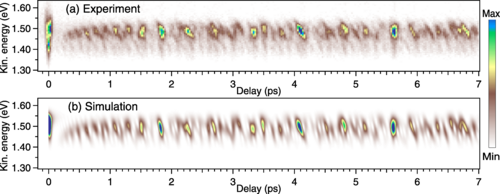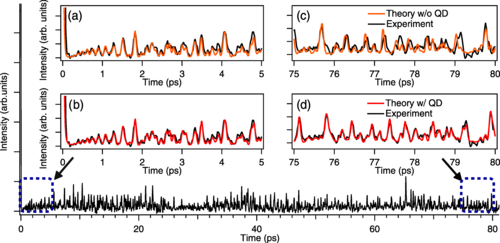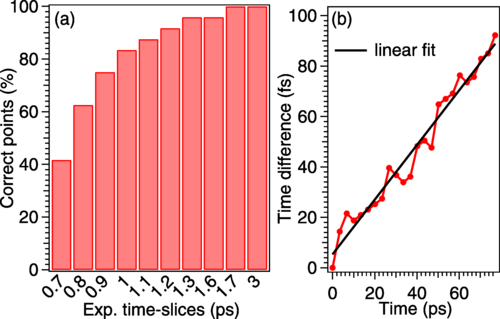Imagine trying to photograph a hummingbird's wings or understand the exact moment chemical bonds form. Many crucial events in science and technology happen incredibly fast, unfolding in femtoseconds – millionths of a billionth of a second.
Measuring time on this scale is vital for progress in fields from medicine to materials science, but it's extremely challenging.
Traditional methods often act like stopwatches, needing a clear "start" signal (time zero) and relying on external counters. These methods can sometimes introduce tiny, consistent errors (systematic errors) that are hard to spot.
Now, researchers have introduced a revolutionary new concept: a "quantum watch" that uses the internal properties of atoms themselves to measure time with inherent accuracy, without needing a defined starting point.
Key Takeaways
- A quantum watch based on the time-dependent photoionization of complex Rydberg wave packets has been demonstrated as a method for artifact-free timekeeping.
- The unique interference patterns, termed quasiunique beat signatures (QUBS), act as a fingerprint of the elapsed time since the wave packet's creation.
- The quantum watch does not rely on a counter and is fundamentally quantum mechanical.
- Quantitative agreement between experimental time-resolved photoelectron spectroscopy of helium Rydberg states and theoretical calculations validates the accuracy of the quantum watch.
- The QUBS can be used to investigate quantum defects of Rydberg states without explicitly measuring their energy.
- The quantum watch can identify and quantify systematic errors in conventional delay stages, such as a drift of about 1 fs/ps observed in the experimental setup.
- A time window of 1.7 ps of the photoelectron yield is sufficient to uniquely determine the elapsed time within a 10 ns range, highlighting the robustness of the QUBS.
- The accuracy of the QUBS-time is estimated to be in the range of femtoseconds.
- The principle of the quantum watch can be extended to other atomic or ionic species and different excitation schemes.

(a) An ultrashort XUV pulse, shown in purple, with center energy close to the ionization threshold, is used for creating a coherent superposition of Rydberg states. Subsequently, an ultrashort NIR laser pulse, shown in red, ionizes the excited atom, resulting in photoelectrons with a kinetic energy of 𝐸kin. (b) Simulation of quantum beats originating exclusively from the interference between levels He 1𝑠13𝑝1𝑃 and He 1𝑠14𝑝1𝑃 with energy separation of Δ𝐸=11 meV. (c) After the XUV excitation, the WP consists of all energy levels between 𝑛=10 and ∞.
How the Quantum Watch Works
This new clock doesn't have gears or digital counters. Instead, it harnesses the strange and wonderful rules of quantum mechanics. Here's the basic idea:
- Excited Atoms: Scientists start with helium atoms. They use a brief pulse of high-energy light (extreme ultraviolet, or XUV) to excite the atoms into special states called Rydberg states. Think of these as "puffed-up" atoms where the outermost electron orbits incredibly far from the center.
- Creating a Mix: The light pulse doesn't just put the atom into one Rydberg state, but a mixture of many different ones simultaneously. This mixture is called a wave packet.
- Quantum Interference: Just like ripples on a pond can interfere to create complex patterns, the different quantum states within the wave packet interfere with each other. This interference creates a unique, evolving signal over time – a complex rhythm or pattern. The researchers call these patterns Quasiunique Beat Signatures (QUBS).
- Reading the Time: Because the energy levels of the helium atom are precisely known (including subtle shifts called quantum defects), the QUBS pattern evolves in a perfectly predictable way. Crucially, this pattern is unique at almost every instant within the lifespan of the wave packet. It acts like a distinct fingerprint for each moment in time.
- The Measurement: To read this fingerprint, a second, time-delayed light pulse (near-infrared, or NIR) hits the atoms. This pulse knocks electrons out (photoionization), and scientists measure these electrons. The intensity and energy of the measured electrons reveal the QUBS pattern at that specific delay time. By matching the measured pattern to the known, predictable evolution of the QUBS, scientists can determine the elapsed time with high precision. This is often done using a pump-probe technique – the first pulse "pumps" the atom into action, the second "probes" what happened after a certain delay.
Why It's Important
This atomic timekeeper isn't just a novelty; it offers significant advantages including inherent accuracy checks, unique timestamping, and inaccuracy identifications through correlation between theory and experiment.
First off the quantum watch has a built-in accuracy check. Scientists can calculate precisely what the QUBS pattern should look like at any given time using the laws of quantum mechanics. If the measured pattern matches the calculation, it confirms the time measurement is accurate. Any unexpected external influence messing with the atoms would cause a mismatch, revealing potential errors.
Because each moment has a unique QUBS fingerprint, you don't need to know the exact "time zero" when the process started. You can simply measure the pattern at any point and compare it to the theoretical map of patterns to find the absolute time elapsed since the wave packet was created. This solves a major headache in many ultrafast experiments.
In their experiment, the researchers compared the time measured by the quantum watch ("QUBS-time") to the time measured by the standard mechanical equipment used to delay the second light pulse ("DS-time"). They found a small but consistent drift in the mechanical stage – about 1 femtosecond for every picosecond (a trillionth of a second) of delay. The quantum watch was precise enough to calibrate and reveal inaccuracies in conventional tools.
The QUBS patterns are extremely sensitive to the exact energy levels of the Rydberg states, including the subtle "quantum defects." By matching the measured patterns to theory, the researchers could experimentally verify these quantum defects with high accuracy, providing a new tool for probing the fundamental properties of atoms.
While demonstrated with helium, the basic principle could be applied to other atoms or even ions, potentially using different types of light (like X-rays) to create the initial wave packet. This opens the door for using quantum watches in a wider range of experiments.
Summary of the Results
The researchers performed experiments using the pump-probe technique on helium atoms. They measured the electrons released by the second light pulse at various delay times.
- Theory Matches Reality: They compared their experimental measurements to detailed theoretical calculations based on quantum mechanics. As shown in Figure 2 (simplified caption below), the complex patterns observed in the experiment closely matched the simulations, confirming the underlying theory.

Figure 2 Caption (Simplified): Comparing the measured results (a) with theoretical predictions (b). The patterns of electron signals changing over time and with energy show a strong match, validating the quantum watch concept.
- Importance of Atomic Details: When observing the patterns over longer times (Figure 3), the researchers found that including the subtle "quantum defects" in their calculations was crucial for getting the theory to match the experiment. This highlighted both the sensitivity of the QUBS and confirmed the accuracy of the known quantum defect values. They could even use the data to measure the quantum defect strength.

Figure 3 Caption (Simplified): Looking at the overall electron signal over a longer time. The experiment (black line) matches the theory (red line) very well only when subtle atomic details (quantum defects) are included (d), unlike calculations without them (c). This confirms the model and shows how the measured pattern (like in inset d) reveals the "QUBS-time."
- Unique Time Fingerprints: To confirm that the QUBS patterns were unique enough to pinpoint time, they took short snippets of the experimental data (like 2 picoseconds long) and checked if they matched the correct time within a much longer simulated timeframe (10 nanoseconds). As shown in Figure 4(a), even short snippets were sufficient to uniquely identify the correct time with high confidence. Figure 4(b) shows the measurement that revealed the consistent drift in their conventional delay stage equipment when compared to the QUBS-time.

Figure 4 Caption (Simplified): (a) Proof that the quantum "fingerprints" (QUBS) are unique: even short time slices reliably identify the correct moment within a much longer duration. (b) Comparing the quantum watch time (QUBS-time) to the standard equipment time (DS-time) reveals a consistent drift in the equipment (the points form a line going upwards).
- Femtosecond Accuracy: Based on the sensitivity of the QUBS patterns to tiny changes, the researchers estimate the accuracy of their quantum watch to be in the range of femtoseconds (around 8 fs in this specific setup).
Conclusion
This research successfully demonstrates a working quantum watch using the intricate dance of electrons in highly excited helium atoms. By reading the unique, evolving quantum beat signatures (QUBS), scientists can measure time intervals on the femtosecond scale with inherent accuracy, without needing a time zero, and even use the atoms to double-check the results and calibrate equipment.
While further development is needed, this quantum approach to timekeeping, potentially adaptable to various atoms and experimental setups, offers a powerful new tool for exploring the ultrafast world, promising deeper insights into physics, chemistry, and materials science.
Simple Glossary
- Femtosecond: An incredibly short time unit: one millionth of one billionth of a second.
- Rydberg Atom: An atom excited so its outer electron is orbiting very far from the center, making the atom much larger than normal.
- Wave Packet: In quantum mechanics, a combination or mixture of different states (like different Rydberg states) that evolve together.
- Quantum Beats (QUBS): The unique, changing interference pattern created by the quantum wave packet, acting like a time-dependent fingerprint.
- Pump-Probe: An experimental technique using two light pulses: the first ("pump") starts an action, the second ("probe") observes the result after a short delay.
Nature's Tiniest Clock: Using Quantum Beats to Keep Perfect Time
Quantum watch and its intrinsic proof of accuracy